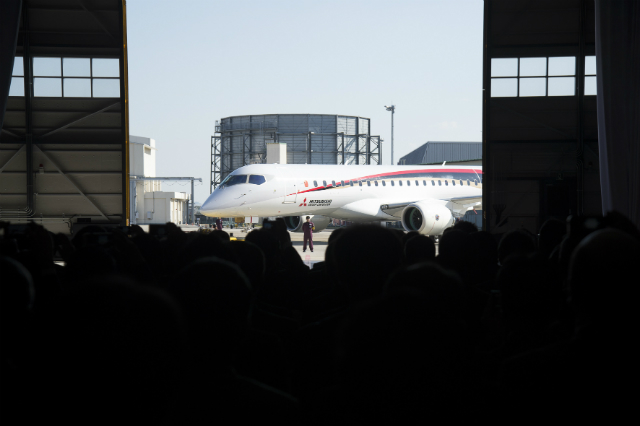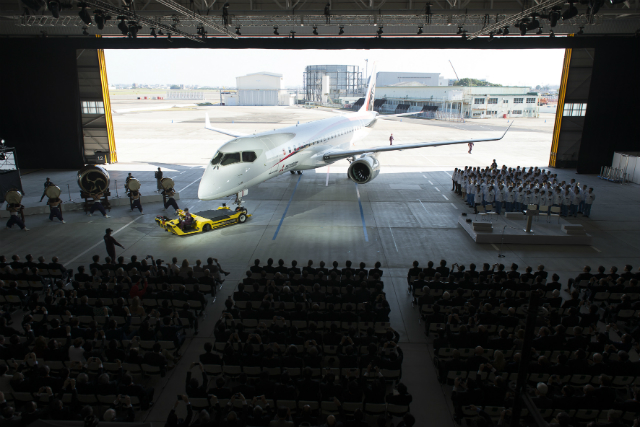When Mitsubishi Aircraft rolled out its first flight test aircraft before a crowd of close to 600 on 18 October, it reached a long-awaited - but largely symbolic - milestone for its MRJ regional jet programme.
The roll out comes in good time ahead of its planned 2Q 2015 first flight, but also marks the start of a challenging journey towards flight tests and certification work for the Japanese airframer.
As the programme advances, Mitsubishi needs to prove that it can build a commercial aircraft on schedule, in volume and, more importantly, up to performance expectations. The project, which has so far cost the company Y180 billion ($1.7 billion), is also Japan’s first commercial aircraft in half a century, since the NAMC YS-11 turboprop terminated production in 1973.
At the roll out ceremony in Nagoya, the aircraft clearly benefits from high Japanese standards and precision, complete with a beautiful finish. Guests all commented on how sleek the aircraft looked.

Mitsubishi Aircraft
Mitsubishi Heavy Industries’ chairman of the board Hideaki Omiya tells Flightglobal he expects Mitsubishi’s biggest challenge will be certification. MHI is Mitsubishi Aircraft’s largest shareholder and manufactures the aircraft's airframe.
He has good reasons to worry since its peer, Chinese airframer Comac, is still struggling to get its ARJ21 regional jet certificated, six years after the aircraft took its first flight.
“I think the most difficult thing is to get certification on time. Since we do not have experience in this area for a long time, we’re now struggling. But I think we can overcome,” says Omiya. “I am quite confident that we can get certification in time and deliver the first shipset to All Nippon Airways in 2017.”
Getting the MRJ certificated on time is a priority since the aircraft is set to be the first regional jet with a next generation engine to enter the market and any schedule slippage would mean losing its first mover advantage. Earlier announced delays to the MRJ programme will now see the Japanese-made jet enter into service in 2017, just a year ahead of its strongest competitor, the Embraer E-Jet E2.
“For the first few years of its life, Mitsubishi’s best friend was Embraer’s reluctance to re-engine its jet family. This has changed. As the E2 continues to gain traction, the MRJ programme will need to prove that it can be competitive even up against an established market leader offering a product with the same engine,” says Teal Group analyst Richard Aboulafia.
He also noted that a number of Mitsubishi’s customers such as SkyWest and Trans States Holdings appear to be “hedging their bets” since they have also ordered the E2.

Mitsubishi Aircraft
Flightglobal’s Ascend Fleet Forecast expects Embraer and Mitsubishi to be the two dominant players in the regional jet market, responsible for 83% of all regional jet deliveries over the next 20 years. Embraer, being the established manufacturer, will take a 61% market share while Mitsubishi will hold 22%.
The MRJ order book now stands at 375 aircraft – 191 firm orders, 184 options and purchase rights. Japan Airlines has also signed a letter of intent for 32 MRJs. As the aircraft starts flying, analysts also expect more orders to stream in from airlines who have been taking a “wait and see attitude”.
MHI’s Omiya also foresees Mitsubishi being one of the two dominant players in regional jet market, with a target for the MRJ programme to gain orders for 1,500 aircraft.
Going forward, Mitsubishi needs to prove that it can series manufacture an aircraft and also provide good product support to ensure that the MRJ is able to deliver on dispatch reliability targets, says Ascend’s head of consultancy Rob Morris.
“MRJ faces the same challenges as any new programme from a new OEM in the market today. Design, integration and certification of a commercial turbofan aircraft, even a regional jet, is a complex task,” he adds.
Source: Cirium Dashboard























